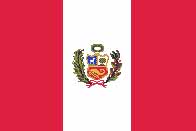 |
Number of versions: 8
Edition: January 22, 2003
|

Most probably Parker Brothers also marketed their Spanish language editions of
Atlantic City in Peru. (So far I haven't got any confirmation.) However,
it is for sure a few regional game manufacturers issued Monopoly editions
as well.
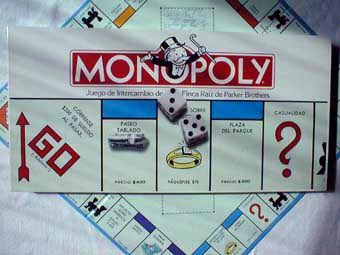 Edition:
International
Spanish language ed., Ref.8009 Edition:
International
Spanish language ed., Ref.8009
"Juego de Intercambio de Finca Raíz de Parker
Brothers (Game of exchange of properties, originally P.B.)
Publisher: Parker Brothers, Inc. - Beverly - 1985
Dimensions of the box: 25.6 x 51.0 cm
The game:
This set has been issued by Parker Brothers in all North-, Middle- and South
American countries where Spanish is spoken, so most probably in Peru as well.
It concerns the well-known American standard edition in the white box with the
streets of Atlantic City, but in the Spanish language.
From Go (¡Adelante!) on all properties
of the International Spanish language edition are:
Avenida Mediterráneo - Arca Comunal
(Community Chest) - Avenida
Báltica - Impuesto sobre Ingresos (Income Tax)
- Ferrocarril Reading - Avenida Oriental -
Casualidad (Chance) - Avenida
Vermont - Avenida Connecticut - En
la .../De visita no más - Plaza San Carlos - Compañía
de Electricidad - Avenida de los Estados -
Avenida Virginia - Ferrocarril
de Pensilvania - Plaza Santiago - Arca
Comunal - Avenida Tennessee - Avenida Nueva York -
Parada Libre (Free Parking) - Avenida Kentucky -
Casualidad - Avenida
Indiana - Avenida Illinóis - Ferrocarril
B. & O. - Avenida Atlántico - Avenida
Ventnor - Obras de agua potable (Drinking-water
Works) - Jardines
Marvin - !Váyase a la Cárcel! (Go to Jail)
- Avenida
Pacífico - Avenida Carolina del Norte
- Arca Comunal - Avenida Pensilvania -
Ferrocarril Short
Line - Casualidad - Plaza del Parque
- Impuesto sobre posesiones de lujo (Luxury Tax) and Paseo
Tablado.
The lid of this "long box" shows the last part of the 4th side
and Go. On top is the red
bar with Rich Uncle Pennybags in the middle O. The dice show numbers 3
and 5. The bottom of the box is un-printed.
The back of the solid game board is blue.
The word Monopoly goes in closed characters in a black frame
sloping over the board. The innerbox
contains except for a small plastic insert with 7 holes for the banknotes also a
filling up piece of blue cardboard on which
the "13 frequently asked questions" are printed in Spanish.
The game is entirely in the Spanish language but the money is in dollars. It are the
well-known banknotes with the mention "Copyright
1935 by Parker Brothers Inc." in the centre circle. The Casualidad (Chance) cards are red and the Arca Comunal
(Community Chest) cards are yellow, both illustrated
with funny pictures of Rich Uncle Pennybags identical to those of the original
American issue.
There are 10 metal tokens "made in Hong Kong", viz.: car
- hat - thimble - dog - boat - iron - canon - rider-on-horse - shoe and wheelbarrow.
The dark green houses and red
hotels with overhanging roofs are made of plastic and do have a centrally
placed chimney. Both dice are white with black pips.
This edition was "Fabricado en los EE.UU" (Made in
USA).
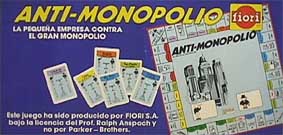 Edition: Antimonopolio. Edition: Antimonopolio.
"The small
entrepreneur against the Great Monopolist"
"This game has been manufactured by Fiori S.A. under licence of Prof.Ralph Anspach
and not by Parker-Brothers."
Publisher: Fiori S.A. - 1987
Dimensions of the box: 47 x 23 x 4 cm
The game:
Peru was the only place in South America where Anti-Monopoly was marketed. It
was marketed so succesfully by Fiori (also on TV) that it outsold Monopoly. It
happened between 1987 and 1990. Unfortunately, the Shining Path uprising then ruined the Peruvian economy and Fiori stopped publishing
board games.
Anti-Monopoly is an upgraded version of the Atlantic City Quaker game named
monopoly.
Professor Ralph Anspach invented the game and Professor Irvin Hentzel did
the mathematics.
In Anti-Monopoly, players play either by monopoly or competition rules fixed
at the beginning of the game. Competitors charge fair rents, build as
soon as they own a property, put 5 houses on their properties and occasionally
go to Price War. Monopolists extort monopoly-high rents from their
poor tenants, build only after they have monopolized a color grouping, restrict
supply by putting only 4 houses on their properties and occasionally
go to Prison.
The good guys are the small entrepreneurs and the bad guys are the
monopolists. Since players do not play by the same rules, fairness is achieved
by a patented technique of equalizing the win probabilities, a technique made
possible only by the computer age.
Anti-Monopoly requires more sophistication and strategic thinking than Monopoly
because competitors make more money than monopolists in the beginning of the
game but monopolists can catch up later, especially if competitors don't watch
their money. This eliminates a weakness in the other game where one often knows
in the beginning who is going to win, even though the game can drag on for a
long time. The conflict between competitors and monopolists adds excitement to
the game.
The game board shows streets of 8 South-American capitals, viz.: La
Paz (Bolivia), Quito
(Ecuador), Lima (Peru),
Santiago (Chile), Caracas
(Venezuela), Bogota (Columbia),
Buenos Aires (Argentine)
and Sao Paulo (Brazil).
The game is "Prod. Peruano".
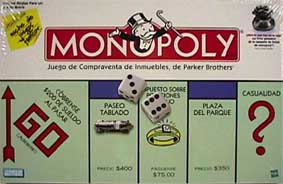 Edition: International
Spanish language edition, ref.08009 Edition: International
Spanish language edition, ref.08009
"Juego de Compraventa de Inmuebles, de Parker Brothers" (Property trading game, of Parker Brothers)
Publisher: Parker Brothers/Hasbro Inc.
- Pawtucket - 1999
Dimensions of the box: 26.9 x 40.2 cm
The game:
The lid of this new "standard box" (shorter than the 1985 issue) also shows the last part of the
4th side and Go. On top is the red
bar with Rich Uncle Pennybags in the middle O. The dice now show the
numbers 3 and 6 but the race car is still on the Paseo Tablado.
The bottom of the box is still un-printed, unlike the similar European editions
showing a "laughing family" around a table playing Monopoly.
In this new box is one narrow, white plastic tray with but 5 slots for the
banknotes and all other equipment. The remainder of the innerbox is
filled up with a light green cardboard
insert showing again the "13 most frequently asked questions".The board is
folded in four and consequently it lies about in the box. The red
Monopoly bar is sloping across the
board. On the game board are the nice looking Casualidad and Arca Comunal
cards.
As addinional (11th) token the "moneybag" has been
added, the winning token from the ±1998 Monopoly new token campaign.
The green
plastic houses and red
hotels have a chimney in the middle of the roof.
Both dice are white with black pips.
This edition also is "Fabricado en los EE.UU" (Made
in USA.
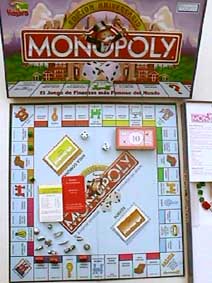 Edition:
Monopoly Edición Aniversario, Art.N° 00819 Edition:
Monopoly Edición Aniversario, Art.N° 00819
Publisher: Parker Brothers/Hasbro Perú S.A. - 2000
Dimensions of the box: 25.2 x 48.3 cm
The game:
This again is the Spanish language issue of an American game, i.a. with the
streets of Atlantic City.
For this anniversary edition the same design is used as for the DeLuxe
versions in many other countries in this same peiod:
 | Alongside the lower part of the colorful lid shows a part of the 3rd
side of the game board with (green)
locomotive in the middle.
In contrast to the DeLuxe editions of other countries there are no
gold tokens on the streets here. |
 | Right on top of this locomotive are 2 white dice showing a 1 and 4
on top. |
 | On top of these dice is the red
Monopoly-bar- with-shadow and Mr.Monopoly out the middle O. |
 | And on top of this finally is a gold colored arch telling this is an
anniversary edition. |
However, in contrast with the DeLuxe editions this box is not high and
therefore it cannot contain a carousel card holder for the banker.
The bottom part of the box shows a nice color picture of the game board and its
accessories, however without the tokens. Because of the fact this is an
anniversary edition a "moneybag" has been added.
The property deeds (58x89
mm) with rounded corners have a blue
back.
The funny illustrated orange colored Suerte
(Luck) and yellow colored
Arca
Comunal (Community Chest) cards are rather small (45x77 mm).
The money consists of one sided printed Monopoly banknotes in low
denominations 1 -
5 - 10 -
20 - 50 -
100 and 500.
Here again the $-sign is used on the game board as well as on the property deeds
and in the Rules.
The 10 metal tokens are the very well-known: boat - car - hoat -
dog - iron - rider-on-horse - wheel-barrow - canon - thimble and shoe. However
it says on the bottom of the box that there are only 8 tokens supplied.
The green houses and red
hotels are made of transparant plastic. They have a chimney in the centre
of the roof.
Both dice are white with black pips. The Rules are printed red
on white paper.
This game is imported from Argentina.
The price of this set amounted to ARS 46.- (= € 13.80) July 2002 in
Argentina.
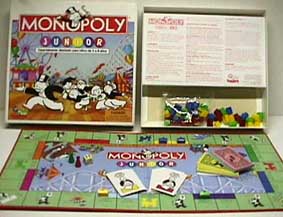 Edition: Monopoly Junior, Art.Nº 441 Edition: Monopoly Junior, Art.Nº 441
Publisher: Parker Brothers/Tonka/Hasbro Perú S.A. - ±2000
Dimensions of the box: 30.3 x 30.3 cm
The game:
The presentation of this Junior edition is according to the American design,
i.a. with a somewhat oblong game board in a square box. It also
bears the "typical" American ref.number 441. However,
it is Fabricado en Argentina.
The long sides have 10 spaces and the short side therefore only have 6. Besides
the sizes of the spaces are rather different. The 1 time folded game
board's back is red. The bottom side of the
box shows a color picture of the board with all its accessories.
Inside the inner box is a cardboard insert with the Rules printed on in red.
Join Rich Uncle Pennybags and his nieces and nephews for a thrill-filled day at
the "Amusements street" - the Roller Coaster, the Magic Show, the
Water Slide the Video Arcade and more.
Four kids can play at the same time, because there are 4 simple pawns
(instead of cars as the picture at the bottom suggests), resp. yellow,
red, blue and green.
The Casitas de Venta (Ticket Boots) distributed at
the start of the game are in the same 4 colors. They very much look the
same like the well-known hotels and they also have a chimney. The moment you
have 2 entretenimientos (attractions) of the same
color you can collect double the fee.
There are 6 Suerte spaces, where cards can be drawn with instructions
like Dirigirse al tobogan de agua (Go to the Water Slide)
and Paga
$3 para tomar el tren para ir al toilette (Pay $3 and take
the train to the toilet). The sizes of these cards are 45x78 mm.
The money consists of 5 one side printed notes (51x83 mm) with Uncle
Pennybags in the centre field in various situation. The denominations are resp.: 1 - 2
- 3 - 4
and 5 $.
The one die is white with black pips.
This game is imported from Argentina.
The price of this set amounted to ARS 28.50 (= € 8.55) July 2002 in
Argentina.
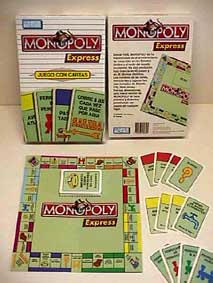 Edition: Monopoly Express, Art.N° 9035
- Juego de Cartas
(Card game) Edition: Monopoly Express, Art.N° 9035
- Juego de Cartas
(Card game)
Publisher: Parker Brothers/Tonka/Hasbro
Argentina S.A. - 2000
Dimensions of the box: 19.0 x 27.2 cm
The game:
Strang enough there are no Rules supplied with this game, made in
Argentina. On the other hand it is manifest it is a happy families game,
because the aim is to make monopolies of one of the famous streets plus
1 or 2 adjacent other fields like Suerte, Arca Comunal, Obras de aguas
corrientes or Compañía de Electricidad. All 4 stations also make a
monopoly, as well as the the 4 corners. The game is again the Spanish language
version of the American town Atlantic City.
A colored bar along the edge of the little game board (26x26 cm)
indicates which 4 spaces belongs to a monopoly.
The Rules of the corresponding American Express
Monopoly Card Game, No.40155 from 1994 tell us:
"At the start of the game for a maximum of 4 players each one gets 4 cards;
the remainder is placed in the center of the game board (on the Pozo space).
The one who is on turn draw as many cards as necessary to bring his hand up to a
total of 5. Next he/she plays one card to the space of the matching property
group on the board. The one who adds the fourth card to 1 color makes monopoly
and put these cards face down in front of him/her.
There is no money, nor houses and hotels, but the
monopolies do have a value in points, increasing from 1 to 8. At the end
of each round each player's number of points are counted. The first player to
reach 50 points, or have the highest score after the final round has been
completed, is the winner ."
This edition is imported from Argentina. The price of
this set amounted to ARS 12.- (= € 3.60) July 2002 in Argentina.
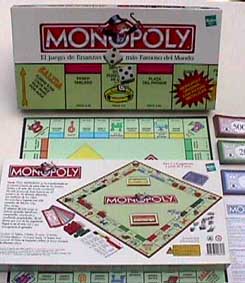 Editon:
Standard
- long little box - Atlantic City - Spanish, Art.N° 00818 Editon:
Standard
- long little box - Atlantic City - Spanish, Art.N° 00818
Publisher: Parker Brothers/Hasbro/The Toy Comp. S.R.L. - 2001
Dimensions of the box: 21.7 x 41.5 cm
The game:
The lid of this long little box shows Mr.Monopoly out the middle O
of Monopoly in the red bar. Because Rich
Uncle Pennybags was not renamed into Mr.Monopoly (with red
bow tie) until 2000 this issue must date from that year as well.
Although this edition has been manufactured in Argentina it still is the Spanish
language issue of the American version, i.e. with the streets from Atlantic City.
Of this both most expensive streets next to Salida are shown on the lid
underneath the red bar. On the lid and all
its rims show the Hasbro logo and in addition there is a
promotion sign saying
"Original Monopoly with metal tokens".
The bottom of the box show a color picture of a game board (with red
back) and all accessories. In reality the board's back is dark blue.
The game board's playside is
folded outwards. The properties are still low prised, reason why you receive but $ 200
over Salida. The property deeds (58x89
mm) with rounded corners have a blue
back.
The funny illustrated orange colored Suerte
(Luck) and yellow colored
Arca
Comunal (Community Chest) cards are rather small (45x77 mm).
The money consists of one sided printed Monopoly banknotes in low
denominations 1 -
5 - 10 -
20 - 50 -
100 and 500.
Here again the $-sign is used on the game board as well as on the property deeds
and in the Rules.
The 10 metal tokens are the very well-known: boat - car - hoat -
dog - iron - rider-on-horse - wheel-barrow - canon - thimble and shoe. However
it says on the bottom of the box that there are only 8 tokens supplied.
The green houses and red
hotels are made of transparant plastic. They have a chimney in the centre
of the roof.
Both dice are white with black pips. The Rules are printed in blue
on white paper.
This edition is imported from Argentina.
The price of this set amounted to ARS 40.- (= € 12.-) July 2002 in
Argentina.
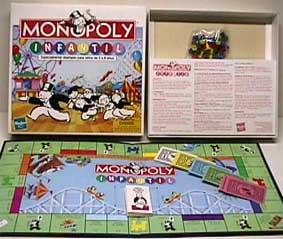 Edition: Monopoly Infantil, Art.Nº 441(Children's
Monopoly) Edition: Monopoly Infantil, Art.Nº 441(Children's
Monopoly)
Publisher: Hasbro Arg. S.A./The Toy
Comp.S.R.L. - 2001
Dimensions of the box: 30.3 x 30.3 cm
The game:
The great difference between this edition and the somewhat older version under
the same Art.N°441 is the translation of Junior into Infantil.
Although it doesn't like very obvious there are still some small differences,
viz.:
 | The board's back is dark blue. |
 | Also here the tokens are no cars but simple pawns-with-
big-base. |
 | The ticket booths are now small, plastic houses with chimney. |
 | The one die only measures10x10x10 mm. |
Of course the Rules are the same.
This edition is also manufactured in Argentina.
The price of this set amounted to ARS 28.50 (= € 8.55) July 2002 in
Argentina.
|